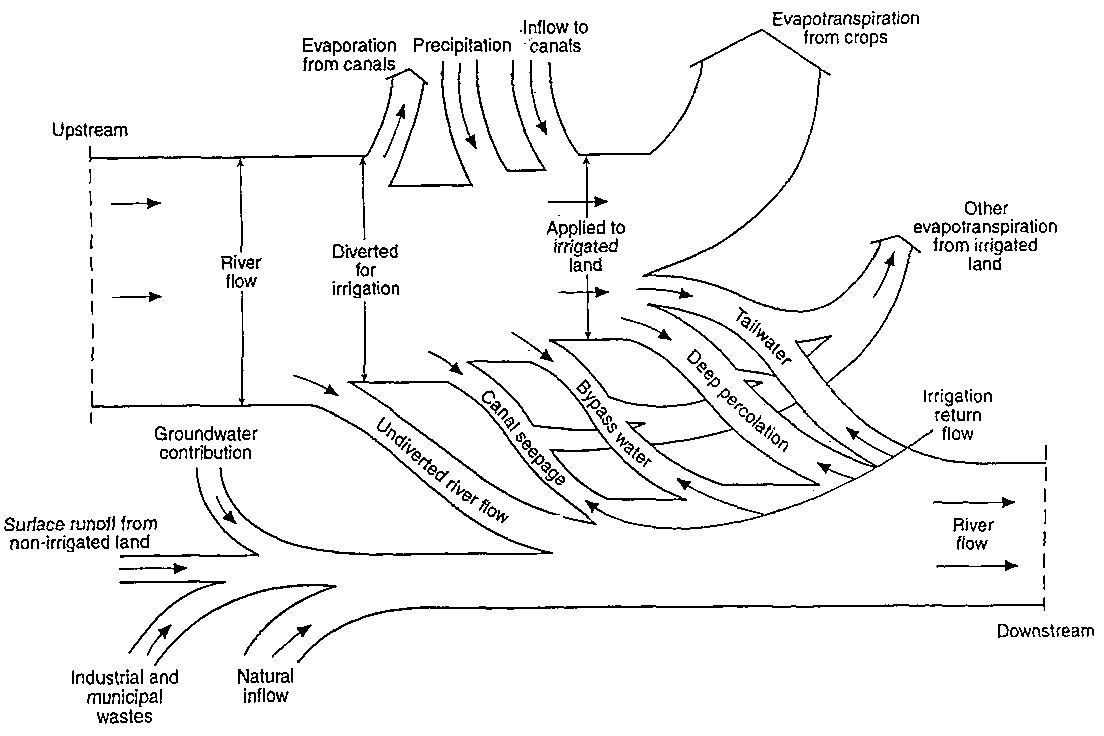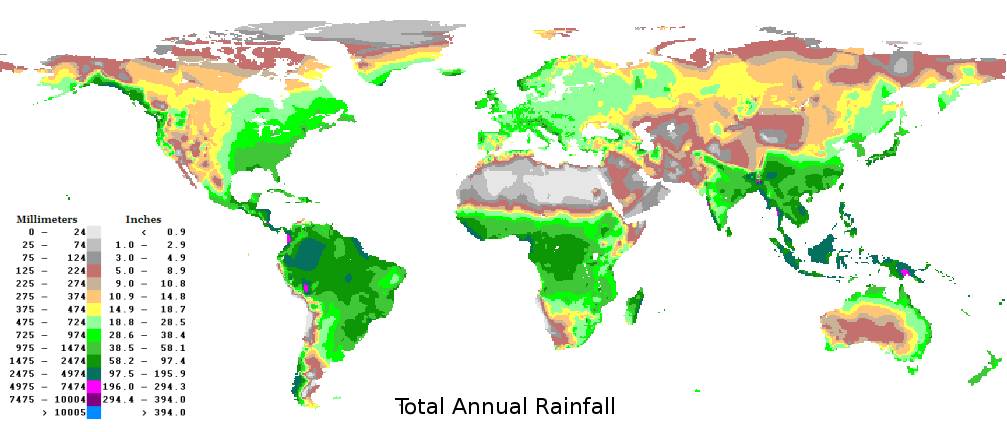According to Stockle (2001), irrigation allows land to be, on average, twice as productive as rainfed land. Even though only 16% of the world’s croplands are irrigated, those irrigated crops produce 36% of the world’s food (World Food Summit, 1996).
| Region | Percent of Food |
|---|---|
| Asia | 60 |
| Pakistan | 80 |
| China | 70 |
| India | 50 |
| Indonesia | 50 |
| Middle East and North Africa | 33 |
| Egypt | 98 |
| Iran | 50 |
| Latin America | 10 |
| Chile and Peru (food crops for export) | 50 |
| Sub-Saharan Africa | 9 |
Source: Wallingford 1997, retrieved from Lipton & Litchfield, 2001, ftp://ftp.fao.org/agl/aglw/docs/misc34.pdf, p.5
Unfortunately, about 70% of the world’s supply of freshwater is already being used for irrigation (UNESCO, n.d.). While expanding irrigation is key to increasing agricultural production, it is clearly limited by the amount of freshwater on this planet.
Figure 1. This diagram shows the path of water used for irrigation. Source: Dougherty, 1995, http://www.fao.org/docrep/v8350e/v8350e09.htm
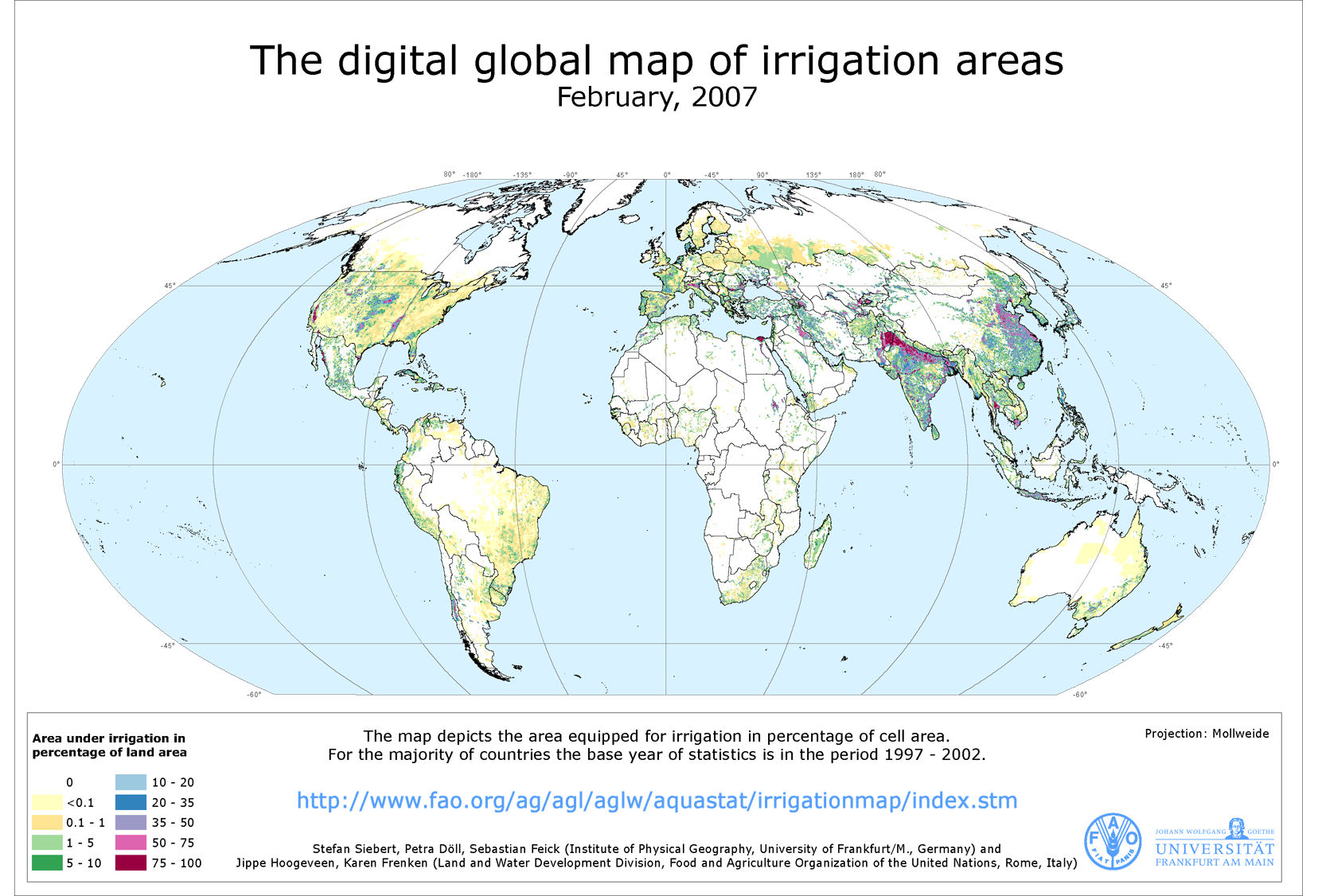
Figure 2. This world map shows what percent of the land is irrigated. Source: Seibert et al, 2007, downloaded from http://www.fao.org/nr/water/aquastat/irrigationmap/index10.stm
In order to maintain the amount of water available to people, the goal is to be able to irrigate more crops while using the same percentage of freshwater.
In considering the solution, one must also realize that irrigation also negatively affects the environment. 95% of the salmon in the Columbia and Snake Rivers are unable to reach the ocean because of the dams and reservoirs built there (Stockle, 2001). The Aral Sea and its 24 unique species of fish in Central Asia are disappearing because its source rivers are being drained for the irrigation of cotton (Stockle, 2001). The land downstream of dried up rivers no longer receive its water and the nutrients that came with it (Stockle, 2001). Withdrawal of underground freshwater increases the salinity of reserve and increases its chances of becoming polluted (Stockle, 2001). The list goes on.
Therefore, the goal is to be able to irrigate more crops while using the same percentage of freshwater, and minimizing the impact of irrigation on the environment.
The Solution
To achieve this goal, irrigation infrastructure must be extended and implemented into more crop areas, a larger source of freshwater must be obtained or created, and more efficient and sustainable models of irrigation must be developed.
Also, changing diets is a reasonable solution to consider, although the change will have to come about culturally with economic or political incentives.
A More In-Depth Explanation of the Problems of Irrigation
Inefficient Use of Water
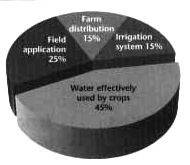 In general, current irrigation methods inefficiently use water. According to World Food Summit, only about 45% of the irrigated water is actually used by the crops (World Food Summit, 1996). As shown by the diagram below, water is wasted in its distribution, ineffective irrigation, and poor irrigation infrastructure (World Food Summit, 1996).
In general, current irrigation methods inefficiently use water. According to World Food Summit, only about 45% of the irrigated water is actually used by the crops (World Food Summit, 1996). As shown by the diagram below, water is wasted in its distribution, ineffective irrigation, and poor irrigation infrastructure (World Food Summit, 1996).
(Left) Figure 3. Distribution of where irrigated water is used. Only the water used effectively by crops is the water not wasted. Source: World Food Summit, 1996, http://www.fao.org/docrep/x0262e/x0262e01.htm
Destruction of Environment
As mentioned above, the excessive use of surface water harms the environment and the ecosystems that depend on the water being exploited.
Groundwater sources must also be used responsibly. In areas where groundwater is quickly replenished and the water table is at a reasonable height, larger amounts of groundwater can be extracted here. Also, more water-intensive crops can be grown. The high inward flux of water allows for more water to be removed, because more water will be replaced.
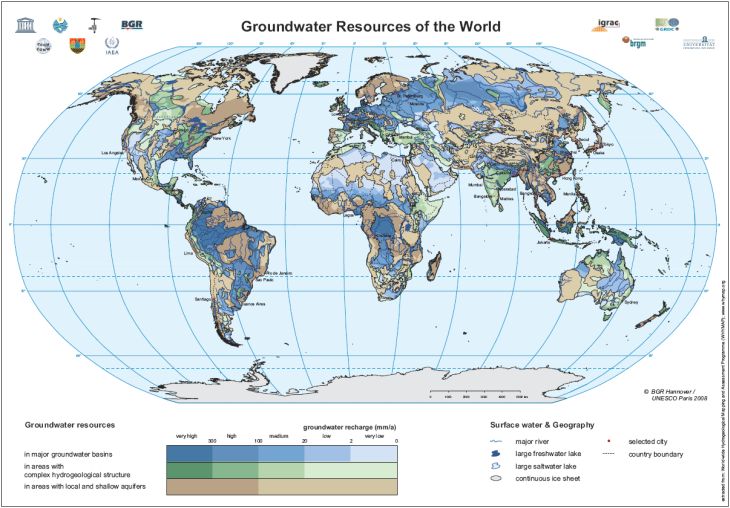
Figure 4. This map shows the various types of underwater resources in the world and how fast the source is replenished (the darker the color shade, the faster the reserve is recharged). Source: WHYMAP, 2008, http://www.whymap.org/cln_144/nn_1055978/whymap/EN/Downloads/Global__maps/gwrm__2008__g.html
Extracting groundwater is not suggested in arid regions, for the water table tends to be slow to replenish, and should not be disturbed, lest the area become even more arid. However, in conjunction with another solution page on the website, each region should only plant vegetation suitable for that region’s climate. Particularly for arid regions, only crops drought-tolerant crops, like sorghum rather than maize, should be planted.
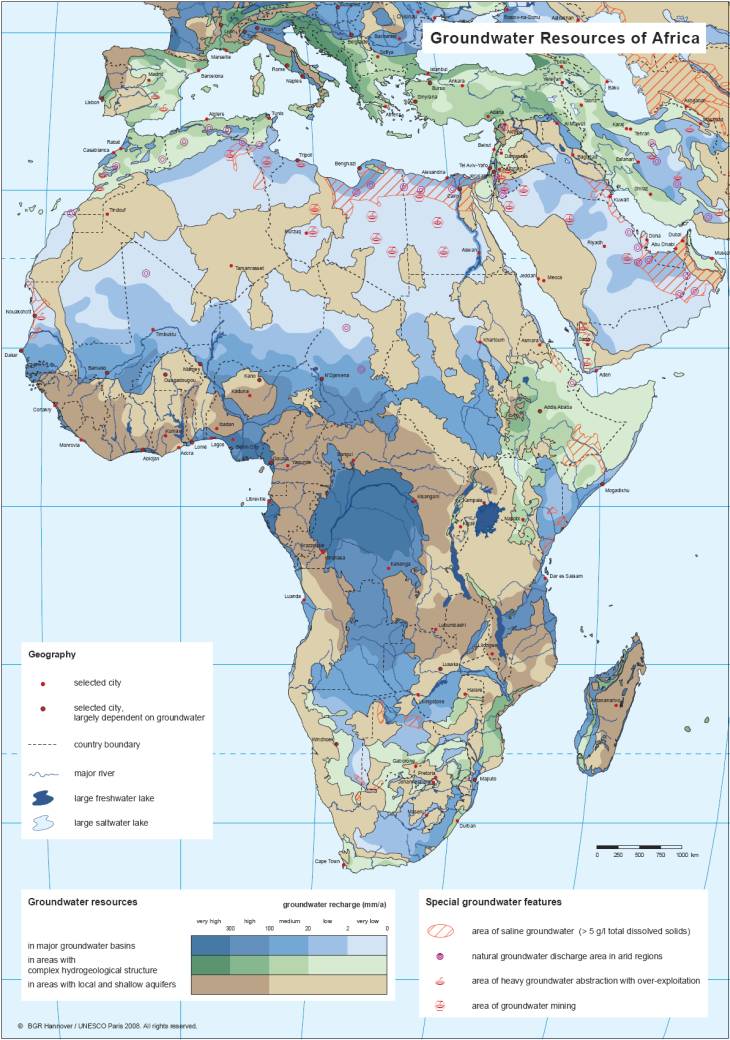
Figure 5. This map is similar too the one above it, but focused on Africa. As this magnification of Africa’s groundwater resource shows, several areas are overusing their groundwater resources. If water is being withdrawn at a rate greater than the rate at which groundwater is accumulating, then that source of water will be depleted. According to Stockle, excessive withdrawal also leads to increased salinity of the groundwater reserve, and makes the pollution of ground-water easier (2001). Source: WHYMAP, n.d., http://www.whymap.org/nn_1055970/whymap/EN/Downloads/Continental__maps/gwrm__africa__g.html
Another big concern is the increasing soil salinity due to the addition of water to the ground. Salinity occurs when the land is waterlogged, or when the rate at which water enters groundwater reserves is greater than the rate at which the water is able to leave (Information for Action, n.d.). The rising water table is more prone to evaporation, and the salts that were in the water are left behind (Stockle, 2001). One reason why this occurs is because deep-rooted vegetation is replaced with shallow-rooted vegetation, allowing the water table to rise (Information for Action, n.d.). Another is due to the excessive irrigation in places without proper drainage systems (Stockle, 2001; Information for Action, n.d.). Salinity due to irrigation also occurs when salty water is used to irrigate crops, and the water is not able to drain the salts farther away from the plants (Stockle, 2001).
| Country | Percent of Land |
|---|---|
| Mexico | 10 |
| India | 11 |
| Pakistan | 21 |
| China | 23 |
| United States | 28 |
Salinization, according to Stockle, is reducing crop productivity in the United States by 25 to 30% (2001). Waterlogging itself, by 2001, affected 10% of all irrigated crops, and decreased productivity by 20% (Stockle, 2001). Waterlogging and salinity affects 50% of all irrigated land (“Water: An Infinite Resource,” 1995).
Source: "Water: A Finite Resource," 1995, http://www.fao.org/docrep/u8480e/u8480e0c.htm
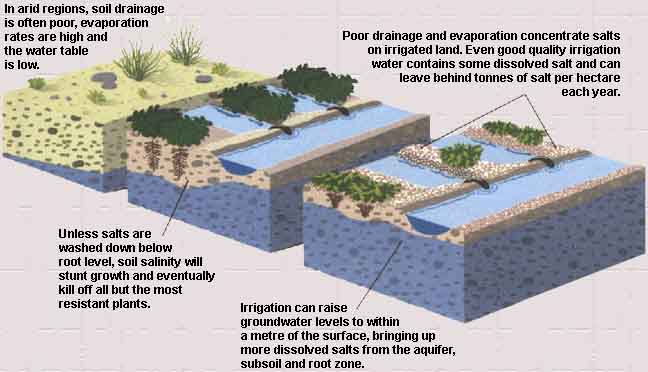
Figure 6. This diagram sums up how salinity results from various situations. Source: "Water: A Finite Resource," 1995, http://www.fao.org/docrep/u8480e/u8480e0c.htm
Development of Irrigation
Developing irrigation models depends heavily on the location of the planned irrigation—several factors to keep in mind are the quality of the region’s soil, water availability, the shape of its landscape, and the type of crop being planted (Brouwer, Prins, Kay & Heiblom, 1988).
Also, the new models have to fix the problems mentioned above—the models must minimize the amount of water wasted and its negative effects on the environment. By doing so, irrigation, and thus farming, becomes easier to sustain.
It is important to mention that improving irrigation efficiencies is not only achieved by improving its technology, but also by regulating its usage so that the water is effectively used. For example, instead of performing irrigations at timed intervals, irrigations should only be performed when the crops actually need the water (Stockle, 2001). If improved irrigation is able to reduce these losses to negligible amounts, twice the amount of land could be irrigated with the same amount of water used today.
Implementing Irrigation
Upon implementing more irrigation infrastructure, proper drainage and irrigation technique must be evaluated to avoid waterlogging of the ground, and thus the degradation of the soil.
It is also important to note that implementing irrigation is expensive. The following link leads to an spreadsheet detailing the cost per hectare of implementing new irrigation and also the modernization of old irrigation.
http://www.fao.org/nr/water/aquastat/investment/IrrigationInvestmentCosts20070416.xls
Generating Water
In areas where rainfall is significant or plentiful, people can build rainwater catchers out of cement, or preferably more local materials that can withstand rain. The water that is caught can then be stored underground to avoid evaporation.
Figure 7. Map of Annual Precipitation. Source: Climate-Charts.com, 2007, http://www.climate-charts.com/World-Climate-Maps.html#rain
In waterlogged areas, the water underground could be reused if the water in the ground were extracted. The water, most likely polluted with nitrate and hopefully full of salts because it drained the soil of its salts, will need to be purified into freshwater in order to be reused. Except we want to keep the nitrate.
Similarly, water harvesting, the collection of run-off water, can be used to obtain the excess water in order to reuse it in irrigation (World Food Summit, 1996).
Waste water is also a good source for irrigation water. Several countries already practice the use of waste water. In the Middle East, using waste water is necessary because of the extreme lack of water available for the farmers’ crops (Stockle, 2001). Research has been done to evaluate the cleanliness of the food grown with waste waters—the plants are shown to have negligible amounts of toxins because the waste water itself does not have the toxin ions in high concentration tostart with (Pescod,1992). However, urban wastewater often carries heavy metals that need to be removed before being used as irrigation water, because the metals will accumulate in the soil and in the plant (Pescod, 1992).
Desalination of salt water can also be developed for coastal farms, particularly where their ground water is being infiltrated by ocean water. However, current technologies are not as large-scale as agriculture demands.
Such technologies to increase the amount of water that can be used for irrigation will be described as water-gathering infrastructure in the rest of the page.
Changing Diets
Different agricultural products have different water requirements, as shown by the table below.
| Product | Unit | Equivalent Water in cubic meters per unit |
|---|---|---|
| Cattle | Head | 4000 |
| Sheep & Goats | Head | 500 |
| Fresh beef | Kg | 15 |
| Fresh lamb | Kg | 10 |
| Fresh poultry | Kg | 6 |
| Cereals | Kg | 1.5 |
| Citrus fruits | Kg | 1 |
| Palm oil | Kg | 2 |
| Puls, roots, tubers | Kg | 1 |
Source: UNESCO, n.d., http://www.unesco.org/water/wwap/facts_figures/food_supply.shtml#top
There is also this table, which shows similar information.
| Crop | Water need (mm/total growing period) |
|---|---|
| beans | 300-500 |
| citrus | 900-1200 |
| cotton | 700-1300 |
| groundnut | 500-700 |
| maize | 500-800 |
| sorghum/millet | 450-650 |
| soybean | 450-700 |
| sunflower | 600-1000 |
Source: Critchley & Siegart, 1991, http://www.fao.org/docrep/U3160E/U3160E00.htm
As these data tables show, there certainly are foods that require less water to grow. By shifting diets to eat more of those foods, water could be used more effectively, since the same amount of water could grow more food. For example, if diets were changed to eat one kilogram less meat, about 10 cubic meters of water would be saved. Those 10 cubic meters of water could be used to grow a bit more than 6 kilograms of cereal, or 10 kilograms of potatoes.
Target Locations
Irrigation will be newly implemented mostly in developing countries, particularly the wetter regions of Africa. All existing irrigation will be improved to become more water-efficient and less environmentally damaging. All irrigated cropland will have nearby water infrastructure, which will gather and purify water if need be. All farmers irrigating their crops will also need to be educated about water management and proper irrigation methods to prevent their land from become too saline or waterlogged.
Implementation
To increase the percentage of irrigated cropland, target governments will be encouraged to expand their irrigation infrastructure. This suggestion will be easily accepted since each government knows the importance of irrigation and its agricultural benefits. For example, the Tanzanian government intends to expand its irrigated land from 625 thousand to 2.5 million acres of land, despite not having enough water to generate electricity or flow in the country’s rivers (Beaubien, 2006). However, the type of irrigation installed needs further analysis to ensure maximum water efficiencies.
Improving existing irrigation technology will have to start from the owners of the technology since they have direct access to it. In order for the changes to be implemented, the government will need to subsidize the cost of the upgrade to make the upgrade even more economically appealing.
In both cases, the development of water-gathering infrastructure and the education of farmers about water management are crucial. Farmers need to understand that in order to keep their land agriculturally active, they cannot withdraw more groundwater than will be recharged and cannot put more water than will be drained away. Both will result in saline environments, and the excessive withdrawal of groundwater and large diversions of surface water harm natural ecosystems as well (Information for Action, n.d.; Stockle, 2001).
Finances and Funding
The entire plan needs funds to cover the expansion and development of irrigation infrastructure, the implementation of water-gathering technologies, and the education of the farmers.
Irrigation infrastructure is extremely expensive. In 2000, the construction costs of new projects ranged from $1000 to $6000 per hectare (“Irrigation Investment Costs”, 2007). Modernization projects cost about $500 to $1000 per hectare (“Irrigation Investment Costs”, 2007). Most projects were funded by the World Bank, but other groups, like Agence Francaise de Developpement (AFD) and the Food and Agriculture Organization (FAO) also donated or lent some money.
In 2003, there were 277 million hectares of irrigated land in the world (Earthtrends, 2007). Fixing all of the existing irrigation would cost about $200 billion. To expand the amount of irrigated land by 40 million hectares in 15 years, a goal set by World Food Summit, $120 billion. So, the entire implementation will cost about $320 billion.
For the project to install water-gathering technologies, the World Bank and non-profit organizations, particularly those interested in water security, will help fund the process, and perhaps supply some volunteers to help with the actual implementation. Even NGOs interested in providing drinking water can support the project, because even though the water-gathering technologies are labeled here for agricultural uses, they too can be used for providing drinking water after the collected water is purified. Other volunteer groups will also be able to help implement the new infrastructure. Some organizations, like Engineers Without Borders (EWB), already are helping out. For example, MIT’s branch of EWB is installing rainwater harvesters, among other things, in Uganda.
According to “An Introduction to Rainwater Harvesting,” the cost of rainwater collection systems is about $1 per liter. Hopefully the numbers for the water-gathering plan are similar. If each farm with irrigation will try to collect and store 1000 liters of water per hectare, that would be about $1000 per hectare. This would add $317 billion to the bill.
Adding to that funding for teaching the farmers, as well as research, the estimate for the total implementation will be $650 billion over the 10 years for research and 15 years of actual implementation, or about $1 billion for the first 10 years and $42.6 billion per year for the next 15 years.
Timescale
We will dedicate 5 to 10 years to developing more sustainable models of agriculture for various regions. After that, actual implementation of new or modified irrigation technologies will start. If the Tanzanian government can shoot to quadruple its area of irrigated cropland in four years, according the Beaubien, then the initial implementation of a project much larger in scale will take at least 15 to 20 years (2010). After the initial implementation, more irrigation and water-gathering infrastructure can be added.
Meanwhile, to slow down the environmental impact of irrigation, the education of farmers can start immediately, as can the development of water-gathering infrastructure.
Unresolved issues
A good model for sustainable irrigation has yet to be developed. Perhaps a modular irrigation technique would be useful to prevent any continuous build up of salts or constant inefficient use of water, but that too needs to be developed.
Overall, this is a really expensive project, especially with the amount of infrastructure that needs to be built, and economically risky. A more cost effective solution should be sought.
(n.d.) An introduction to rainwater harvesting. Retrieved November 29, 2010, from http://www.gdrc.org/uem/water/rainwater/introduction.html
Beaubien, J. (2006, April 28). Problems plague ambitious irrigation plan in Africa. NPR. Retrieved November 29, 2010, from http://www.npr.org/templates/story/story.php?storyId=5369441
Brouwer, C., Prins, K., Kay, M. & Heiblom, M. (1988). Irrigation water management: Irrigation methods. Retrieved November 28, 2010, from the FAO website: http://www.fao.org/docrep/S8684E/S8684E00.htm
Climate-Charts.com. (2007). Total annual rainfall [map]. Retrieved November 29, 2010, from http://www.climate-charts.com/World-Climate-Maps.html#rain
Critchley, W. & Siegart, K. (1991). Water harvesting. Retrieved November 28, 2010, from the FAO website: http://www.fao.org/docrep/U3160E/U3160E00.htm
Dougherty, T.C. (1995). Environmental impact assessment of irrigation and drainage projects. FAO Irrigation and Drainage Paper, 53. Retrieved November 29, 2010, from the FAO website: http://www.fao.org/docrep/V8350E/V8350E00.htm
Earthtrends (2007). Agriculture and food—Land: Irrigated land. Retrieved November 29, 2010, from http://earthtrends.wri.org/searchable_db/results.php?years=all&variable_ID=195&theme=8&country_ID=all&country_classification_ID=all
Information for Action. (n.d). Salinity. Retrieved November 29, 2010, from http://www.informaction.org/index.php?menu=menua&main=salinity_gen&subject=Salinity
Irrigation Investment Costs. (2007, April 16). Retrieved November 29, 2010, from http://www.fao.org/nr/water/aquastat/investment/IrrigationInvestmentCosts20070416.xls
Lipton, M. & Litchfield, J. (2003). Preliminary review of the impact of irrigation on poverty. Retrieved November 29, 2010, from ftp://ftp.fao.org/agl/aglw/docs/misc34.pdf
Pescod, M. B. (1992). Wastewater treatment and use in agriculture. FAO irrigation and drainage paper, 47. Retrieved November 29, 2010, from FAO website: http://www.fao.org/docrep/T0551E/T0551E00.htm
Seibert, S., Doll, P., Feick, S., Hoogeveen, J., & Frenken, K. (2007, Feburary 16). Global Map of Irrigation Areas [map]. Retrieved November 29, 2010, from http://www.fao.org/nr/water/aquastat/irrigationmap/index10.stm
Stockle, C. O. (2001). Environmental impact of irrigation: A review. Retrieved November 27, 2010, from http://www.swwrc.wsu.edu/newsletter/fall2001/IrrImpact2.pdf
Walker, R. (1989). Guidelines for designing and evaluating surface irrigation systems. FAO irrigation and drainage paper, 45. Retrieved November 28, 2010, from the FAO website: http://www.fao.org/docrep/T0231E/T0231E00.htm
Water: An infinite resource (1995). Dimensions of need—An atlas of food and agriculture. Retrieved November 29, 2010, from the FAO website: http://www.fao.org/docrep/u8480e/u8480e0c.htm
WHYMAP. (2008). Groundwater resources of the world [map]. Retrieved November 28, 2010, from http://www.whymap.org/cln_144/nn_1055978/whymap/EN/Downloads/Global__maps/gwrm__2008__g.html
World Food Summit (1996, 13 November -17 November). Food for all: Water and Food Security. Retrieved November 28, 2010, from the FAO website: http://www.fao.org/docrep/x0262e/x0262e01.htm
UNESCO. (n.d.). World Water Assessment Programme. Retrieved November 28, 2010, from http://www.unesco.org/water/wwap/facts_figures/food_supply.shtml#top
USGS. (2010, March 29). Irrigation techniques. Retrieved November 28, 2010, from http://ga.water.usgs.gov/edu/irmethods.html
